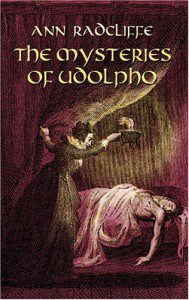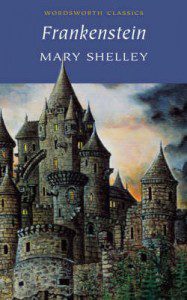 February is the shortest month of the year, noteworthy for Valentine’s Day and making the annual batch of pancakes (poorly, in my case, and to the detriment of my kitchen!) and for the last two years it has played host to Women in Horror Recognition Month. I may be a month too late but, as a woman in horror, I wanted to devote my first column to thinking about this issue, as well as tracing the antecedents of women’s writing in the genre.
February is the shortest month of the year, noteworthy for Valentine’s Day and making the annual batch of pancakes (poorly, in my case, and to the detriment of my kitchen!) and for the last two years it has played host to Women in Horror Recognition Month. I may be a month too late but, as a woman in horror, I wanted to devote my first column to thinking about this issue, as well as tracing the antecedents of women’s writing in the genre.
For many, women in horror is a pertinent issue all year round. Whether a gender imbalance exists is frequently discussed on panels and in interviews, and women writers specifically (myself included) are asked how they fare in a supposedly male-dominated arena. Reassuringly, most writers reply that being a man or a woman has not helped or hindered them in their profession. But the fact these questions are still asked, the fact that a month of the year is dedicated to ensuring women get a fair shot, implies that we still have a way to go.
All of this strikes me as surprising, considering that women have always been writing horror right from the very beginning. The emergence of the Gothic in the late eighteenth century was firmly rooted in a feminist past. Most of these writers were women and the intended audience was also female, with many novels appearing serialised in ladies’ magazines. Early Gothic texts were dismissed with the same derision as chick lit books today, as ‘sofa companions’ not worthy of serious literary merit. Yet storylines focusing on young female protagonists battling the supernatural and uncanny, as well as fighting forbidden desires and appetites, were remarkably popular and provided a much needed escapism for many women trapped by social conventions. In fact, Ann Radcliffe’s The Mysteries of Udolpho (1794) is considered to be the first ‘bestseller’ and this early wave of Gothic fiction established many of the tropes of the genre that still exist in horror fiction today.
Yet there was growing concern for women’s exposure to this kind of literature. Jane Austen’s Northanger Abbey (1817) is an excellent parody about the dangers of women reading too many gothic stories. Austen’s young and impressionable heroine Catherine Morland, having read too many ‘horrid’ books, conjures monsters of her own making, and gives in to her ‘feminine’ curiosity in unearthing Northanger’s secrets. However it is not the supernatural that haunts Northanger as Catherine supposes but a man made unhappiness. Austen’s novel ridicules the fact many believe women cannot separate fact from fiction – they are too easily influenced, too impressionable and far too delicate for horror.
Just when such an attitude – women being too delicate for horror – began to gain credence I’m not sure, but the Gothic, previously considered ‘feminine’ because of its focus on the emotional as opposed to the more ‘masculine’ attributes of reason and science, moved into a male domain. And it wasn’t just women reading horror that was a problem; male critics of the time were also concerned about the dangers of women writing. The fact that early Gothic fiction could be seen to encode anxieties about patriarchy and male control meant that many women writers were aligned with feminist figures such as Mary Wollstonecraft (mother of Mary Shelley – and we all know who she is…).
The connections between horror and feminism were perhaps more pronounced at the end of the nineteenth century with women writers adopting the short story as their weapon of choice to bring about social change. The roots of the horrors that concerned these ‘New Women’ were marriage, motherhood and female health- with particular focus on hysteria. The short story was an apt form to express their ideas succinctly to reach a wide readership, with their work appearing in avant-garde magazines like The Yellow Book and The Savoy. Charlotte Perkins Gilman’s ‘The Yellow Wallpaper’ is perhaps the most famous example from this fruitful period, cautioning against the dangers of rest cure, whilst championing women’s rights to shape the pattern of their own lives (more on this in a forthcoming article in Shadows and Tall Trees). Other writers, such as Charlotte Mew and Vernon Lee, wrote about the horror of degeneracy, as well as the fear of colonialism and the Other.
 But these women writers are virtually eclipsed by their male contemporaries. When we think of the Gothic at the end of the nineteenth century, it’s novels we think of. It is Bram Stoker’s Dracula, Wilde’s The Picture of Dorian Gray and Stevenson’s Dr Jekyll and Mr Hyde that come to mind. I’m not sure if this was because the short story was no match for the novel (a discussion for another column perhaps) or because women writers were so much more concerned with women’s rights that the gothic elements of their stories came second to their political agenda. Even now, these short stories are not marketed as speculative fiction, though they contain many of the ingredients, but as ‘women’s writing’.
But these women writers are virtually eclipsed by their male contemporaries. When we think of the Gothic at the end of the nineteenth century, it’s novels we think of. It is Bram Stoker’s Dracula, Wilde’s The Picture of Dorian Gray and Stevenson’s Dr Jekyll and Mr Hyde that come to mind. I’m not sure if this was because the short story was no match for the novel (a discussion for another column perhaps) or because women writers were so much more concerned with women’s rights that the gothic elements of their stories came second to their political agenda. Even now, these short stories are not marketed as speculative fiction, though they contain many of the ingredients, but as ‘women’s writing’.
Fortunately, the Gothic is now regarded as a serious genre, worthy of the canon and taught as part of the educational syllabus. Women writers are by no means absent; prior to Dracula, The Picture of Dorian Gray and Dr Jekyll and Mr Hyde we have Emily Bronte’s Wuthering Heights, her sister Charlotte’s Jane Eyre, Braddon’s Lady Audley’s Secret, and (slightly earlier) Mary Shelley’s Frankenstein, all are key texts in the genre.
So, when did women get ousted from horror? Or rather, when was it assumed that this had happened?
I’m afraid I don’t have the answers to those questions. What I do know is that when I began to write horror I wasn’t concerned with gender issues. I just wanted to write stories. In fact, I decided to write under my initials not because I wanted to hide my gender, or because I worried about being discriminated against as a woman, but because I wanted my stories to be judged on merit alone.
Personally, I’m not sure how I feel about categories such as Women in Horror. My fear is that such distinctions only serve to perpetuate segregation. A book proudly declaring its all female writer content serves only to suggest that male writing is the norm. On the other hand, when I consider the difficulties facing women writers in the past, when women had to use male pseudonyms just to get published, or going even further back, when women had to profess being possessed by the voice of God in order to justify their right to speak out, it makes me aware that we are still dealing with the repercussions of centuries worth of inequality. Any attempts to acknowledge and redress this imbalance and to ensure it doesn’t happen again, has to be a good thing.
It is good that we have months like February so that along with the Valentines paraphernalia and the pancakes we can remember to celebrate the voices of horror who have contributed to making the genre what it is today.
V.H.LESLIE
If you enjoyed V.H. Leslie’s column, please consider clicking through to our Amazon Affiliate links and buying some of her fiction. If you do you’ll help keep the This Is Horror ship afloat with some very welcome remuneration.










4 comments
Skip to comment form
Great article! I just finished reading Helen Grant’s book The Sea Change & Other Stories and was delighted to reenter the world of psychological horror instead of all the blood and guts that seems to litter the literary field today. Loved your blog post, I’ll have to go look up some of the less familiar authors you mentioned. Loved Northanger Abbey and Frankenstein. I hadn’t heard of Ann Radcliffe but now I’m curious.
Thanks, V.H. Leslie.
I’m certain you’ll also have a resounding impact on the genre.
Good article. The perceived role of women in horror is, perhaps, a reflection of the perception of women in (Western, at least) society: generally speaking, we are not taken seriously.
However, in the 20 years I’ve been writing, I have noticed more and more women being published, at least in the small press/slipstream genre. Still, I think we do not achieve the gravitas that male artists automatically appear to get. To put it in more adolescent terms, women are rarely seen as ‘cool’. But I think it is also true that women do not blow their own trumpets as much as they should, and I have been as guilty of this as anyone, and not just in my writing.
NB: a recent example – Sinead O’Connor being recently described as having ‘gone batty’ for having some mental health problems and alleged suicide attempts. Male musicians with similar issues have been described as tortured, fragile, mad genius’ etc. I saw O’Connor perform on the ‘Later’ programme earlier this year and saw an amazing, passionate, spiritual performance from a very strong woman.